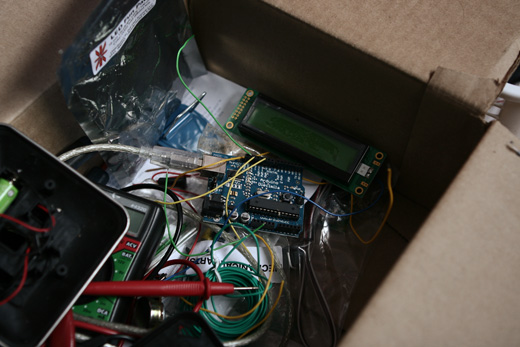
As part of a Canada Council for the Arts Inter-Arts Research and Creation grant I received, I will be documenting my work on the project through here, as I anticipate it will cross over into other projects we work on and came out of past projects we’ve completed.
This project comes out of Broken City Lab‘s previous work on Text In-Transit, where I’m hoping to open up a continuing flow of those kinds of texts in relation to a public space like a bus, or bus stops, or the downtown terminal. It’s likely that we’ll be working with Transit Windsor again on this project as it moves along. The project will connect this kind of publicly-engaged work I’ve done with BCL with some of my digital work I’ve done in the past.
The project is going to involve a lot of experimenting with Arduino-controlled LCD screens, and efforts towards capturing sms text messages, twitter updates, and emails and pushing them all into an LCD display. This will be the foundation of the project anyways.
I’m assuming this is going to involve a combination of interfacing Arduino with Max or Processing and using Perl or maybe PHP to do the text processing (depending on how involved it is), though it may end up taking another route altogether, but that’s what this time is for. I’ll be spending the next few months working through these aspects of the project, while also building towards an approximation of a public installation. I’ll spill more details as time goes on, and I’ll be documenting my progress, as I’ll undoubtedly need notes of my own, and why not keep them on here?
For now, I’ll be working through some basic tutorials, and eventually heading up to InterAcces for some of their workshops.
I would like to thank the Canada Council for the Arts for their generous support in this project. I’ll be acknowledging their support with their logo on each post that I write while documenting this project.


nice to see you got a arduino. i love adafruit.
I’ve had it for a while and did a little bit of experimenting with it last year, but it’s been in that box for quite a while. It’ll be good to pull it out and start trying to figure it out again. I really like adafruit tutorials, very helpful!
this book might be helpful to you
http://www.freebookspot.in/Books-Practical%20Arduino%20Cool%20Projects%20for%20Open%20Source%20Hardware.htm
Haha, are you copying me now Justin? Though if you are it’s okay. I think we’ll be coming up with a lot of interesting results through both of our experimentations. I just got a PS2 EyeToy which I want to use with some GRL programming like Laser Graffiti. http://www.brokencitylab.org/blog/the-eyewriter/
Darren, thanks for the link!
Stephen, good luck with your experiments, we should definitely compare notes in a little while. Keep me posted on your progress.
No problem. Hope you were able to download it. I was at phog tonight and tom was showing old photos, had some of you up on the screen from when your band played there long ago. : )
I did a similar kind of project — a wireless LCD text display. The text displayed on the LCD was input using a web page. I wrote two simple client server applications in Perl.
The first application was called XBsrv and provided a socket interface to an XBee. The second application was a simple webserver that opened a socket to XBsrv. The webserver serves up a simple form with
an entry box and button. When the button is pressed
the entry box text is sent from the webserver to XBsrv using the socket. The XBee runs in transparent mode so it just transmits all received text.
The Arduino application just receives text from the
serial port (via the XBee) and displays the text.
A picture of the hardware setup is at http://tinyurl.com/yl2emph
The hardware uses Arduino software with a ‘168/’328, has an LCD screen and a 2-AA battery pack with a boost converter.
That project sounds very cool … thanks for breaking it down so simply (it helps to know this is entirely possible). And yes, it’s not that far off from what I’m hoping to do… so thanks for the insight!
You’re welcome. The perl code is not difficult. Each server application is around 30 lines of “business” code.
When I release my XBee mesh network nodes I plan to release these applications as examples.